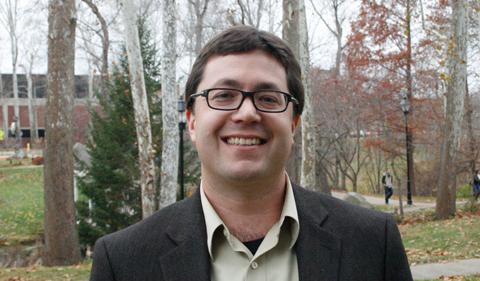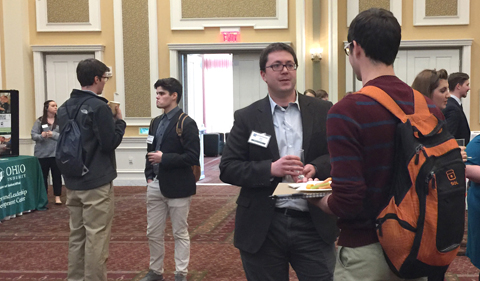
Dr. Joel Vaughn
Ohio University alum Dr. Joel Vaughn (B.S. HTC Engineering Physics ’05, B.S. Electrical Engineering ’06, Ph.D. Physics ’10) returned to the Ohio University Athens campus recently to participate in an Alumni & Student Networking Reception.
The event was part of the College of Arts & Sciences Career & Networking Week. Vaughn was an invited speaker at a recent Physics & Astronomy colloquium as well, where he shared tips about how to approach physics challenges and collaborate with non-scientists when working in industry.
Vaughn is President of Wolfram Labs, a Columbus-area R&D company, which offers a range of science and engineering expertise, equipment design, and manufacturing product development.
In the Q&A below, Vaughn describes why and how his current position of leading a company keeps him moving. He also reminisces about his undergraduate and graduate days studying physics at Ohio University from 2001-10.
Q: How would you describe what you do at Wolfram?
I’m in product development and research and development for hire. I go beyond consulting; I get in there and get my hands dirty and solve their problem. I’m mostly focused on materials, but I don’t limit myself to that. Hypothetically, it could be as simple as a company that makes cookies and they’re having problems with the wrappers staying closed. They can’t figure out why so you go in and say, “well—it’s because you’re over spraying oil on them. And if they say they have to do it that way, then you go in and figure out a way how to get the wrapper closed.
Q: What’s something really exciting about what you’re doing right now?
It’s exciting to try to build a business. You have your highest highs and lowest lows. You’re learning a ton about business and how it works, a ton about how to work with customers. You’re learning about new technology and how to implement it. You get to visit customers that are making things that you would never think have that much technology but are really quite heavy in technology.
For me the exciting thing about the business is being able to work on a lot of different projects and solve a variety of different problems as opposed to just a kind of specialty area. But the idea is to eventually have a niche where we’re really good.

Vaughn meets with a student at the Alumni & Student Networking Reception, sponsored by the College of Arts & Sciences and OHIO’s Career and Leadership Development Center.
Q: What advice do you have for your freshman self if you could go back in time?
Something I wish I would have done while I was an undergraduate would have been take more business classes, especially now being an entrepreneur. And pay attention more and trying to learn more—to focus on absorbing as much as the material as possible.
Q: When you were growing up, when did you realize that you wanted to study engineering and physics?
In all honesty, it was probably while watching the film Back to the Future (Back to the Future is a 1985 American Sci-Fi adventure comedy film starring Michael J. Fox who plays a teenager, sent back in time to 1955. His friend is the eccentric scientist “Doc” Brown, who helps him.) Remember Doc Brown, the crazy guy running around? He seemed like he was having fun and learning about things. As I was growing up, I wanted to be an electro-mechanical engineer.
A local newspaper would come to the elementary school and ask what do you want to be—a fireman? I thought about it and was like—I want to be an electro-mechanical engineer!
Q: When you were in high school, did you have a teacher who had an influence on you in your decision about what you were going to do after high school?
Both my Biology and Chemistry/Physics teachers at Zane Trace High School were strong mentors. Mr. Clark taught Biology and Mr. Scott was the Chemistry & Physics teacher. Mr. Clark would send me here for Science Fairs. Mr. Scott had gone from industry to teaching intentionally. He really challenged us.
These men had two different teaching styles. Mr. Clark was more easy-going, to try to feed you the answers. I wasn’t necessarily interested in biology, but thanks to him I remember a lot of Biology. What he taught us stuck.
Mr. Scott taught with the mentality, “I don’t have to be here, I can go back to industry, so sit down, pay attention, and I’ll feed you material at a fairly fast pace.” In a way that was good—he challenged us. He fed us so much material, that most of my first year of Chemistry at Ohio University was a review.
Q: What was it like being a student at Ohio University’s Honors Tutorial Program? That is, how did you decide on HTC versus other degree programs?
I was the first person to go to college in my family, at least in generations. I didn’t know anything, really. I came here because I knew I wanted to double major. I wanted to study electrical engineering and I wanted to study physics. I got accepted into the Russ College of Engineering. Then I came to the Physics Department and I met with Dr. David Ingram. I didn’t have an appointment or anything, but he brought me into his office, and I told him I wanted to major in physics. Being naïve, I thought I had to have that done before I started the first day.
Dr. Ingram told me that I should really look into HTC because double-majoring is a lot easier. And you wouldn’t have to do a foreign language requirement. And I’m like, “I’m listening.” Because I struggle with English, let alone another language! (Laugh.) So I’ll entertain this idea.
Q: What made you want to major in physics before coming here?
For the longest time I was going to go into electrical engineering. I had had physics my senior year and had really liked the idea of understanding the world around you and pursuing truth.
My dad’s boss had a physics background, and I met with him on several occasions. He kind of inspired me to go that route. He owned his own business in marking technology in Chillicothe.
My dad had a machine shop, and I remember he made this comment to me, “Why aren’t you out in the shop making stuff?” His point was you say you want to be an electric mechanical engineer. “I see you do a lot of electrical stuff but not mechanical. Maybe you should rethink what you want to do.”
Q: Once you came to Ohio University, what was it like?
I had to get up to speed on certain courses; I didn’t have any AP opportunities at my high school. I lived on West Green for half the year then I switched to East Green in Perkins Hall. Outside of class, I fenced for a year or so, and joined a Campus Ministry group. I lived three years in the dorm and then moved into an apartment across the river.
Q: What was it like to learn physics in our department?
My second summer I was at Ohio University, Dr. Saw Hla offered me a paid summer internship. My project was to design some equipment for a new STM (scanning tunneling microscope) that was being built. He had a manipulator that didn’t quite reach as far enough because of a design issue. It needed to be extended with one manipulator—with one linear drive be able to extend and grab a sample. It involved two spring constants and being cryogenic and heated. Dr. Saw let me as an undergraduate get in there and get my hands dirty with the equipment. He taught me a lot about vacuum systems.
I taught freshman physics labs my senior year. I taught Physical Science 105—the beginning physics class. It was fun. It prepared me for being a teaching assistant. Once you were a senior they would allow you to TA these lower level labs.
Q: What made you decide to remain at Ohio University for your graduate studies?
At the time I was finishing up my degree in Electrical Engineering when I started my first year in graduate school. I knew I was going to be here for at least another year to finish up three required courses in philosophy and sociology for my engineering degree.
I was working on a project with Dr. Martin Kordesch using a scanning tunneling microscope that involved transmission electron microscopy. At the time Dr. Kordesch was beginning to work on cathodes, and it seemed interesting to me. It was a change in pace, and it seemed like there would be a more direct industrial application.
Q: What was it like to be a student with Dr. Kordesch?
It was a good fit; it was a matching of personality. He was the adviser I needed—he’s interested in what the student needs to succeed, even if it’s not an area he’s working on. And once I discovered Dr. Kordesch knew what a 4-40 screw is and how to operate a lathe, I thought this was someone who understood me. He is really good at pushing you with the back of his hand to help shape you into a better scientist. It was also a lot of fun! As an example, I remember one day when I first started working with him in the lab he said something along the lines of, “come over here and tell me this crystalline orientation.” I was a little nervous. It’s easy in the classroom, but to be handed a broken wafer in the lab… I said, “oh, 111.” It was a simple thing, but a great teaching moment.

















Comments